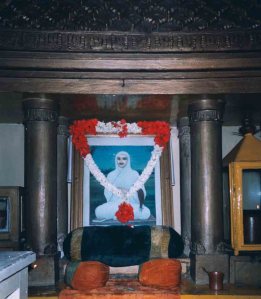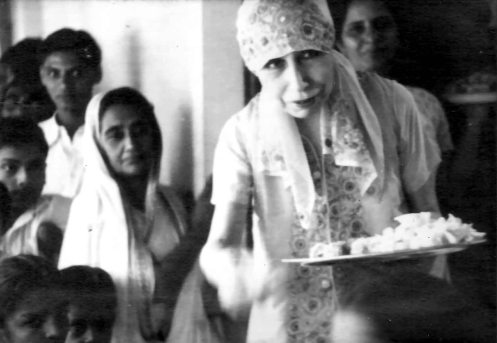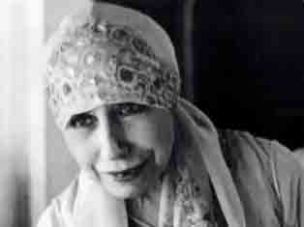
Painting of Chidambaram Ramalingam at Karunguzhi
Thai Poosam, the day which falls in the asterism of ‘Poosam’ (Pushya in Sanskrit, ‘Cancri’), in the Tamil month of ‘Thai’ (January-February) occasions much religious celebration in the temples of Tamil Nadu. Worship offered on the day is considered specially meritorious. This day falls on Jan.30 this year (2010).
It generally coincides with the full moon, and is important in many temples of the state (the Shiva temple at Tiruvidaimarudur in Thanjavur district, and the famous Muruga shrine in Palani for instance). Thai Poosam has been celebrated for more than thousand years as can be seen from the seventh century Saiva boy saint Jnanasambandar’s reference to a great celebration of the day at the famous Mylapore temple in present-day Chennai. ‘Thai Poosam’ is also celebrated with great eclat by the Tamils living in Malaysia and Singapore. At the Nallur Kandaswamy temple in Jaffna, Sri Lanka, Tamils irrespective of their religion, are known to take part in the Thai Poosam. But the Tamils of Jaffna have for decades been a battered lot, and now almost a vanquished ethnic group. May the gods give them and their Sinhala brethren some sense of the sanctity of human life.
Thai Poosam also marks a climacteric point in the life of the 19th century mystic and religious and social reformer, who called himself ‘Chidambaram Ramalingam’, but was worshipped as ‘Ramalinga Vallalaar’ (Ramalinga, the beneficient) or ‘Arutprakasa Vallalar’, the Beneficent bestower of grace and light.
He is said to have locked himself up in a room at his modest quarters at ‘Siddhivilaagam’ (The house of illuminination or attainment) on this day, a hundred and thirty six years ago (30.1.1874). There was no trace of his body afterwards. He was said to have attained a deathless (invisible) body. In the final years of his life, Chidambaram Ramalingam envisaged the worship of God as Light, and got built at Parvatipuram, also called Vadalur, an octogan-shaped structure with a domed roof, in which the light was shown after the removal of seven veils in different colours representing different forms of ignorance.
On Thai Poosam day, every year, a few lakh devotees assemble at the shrine (gnaana sabha, the court of knowledge, as he named it) to witness the light of the formless god. On its part, the Tamil Nadu government declares a holiday and closes all the liquor shops in the state (helping blackmarketeers make a killing by selling liqour on the sly).
Chidambaram Ramalingam was born at Marudur, a nondescript village about 15 kms from the pilgrim centre Chidambaram, on Oct. 5, 1823. His father Ramiah was a village accountant and elementary school teacher. Ramalingam was the fifth issue of Ramiah and Chinnammai. They belonged to the Karuneegar caste, which abjures meat-eating (non-killing and love for all creation was one of the principles that the latter-day saint espoused). Having seen the passing of five wives before he could raise a family, Ramiah was obviously a tired and aging man and died when Ramalingam was just a few months old. The family gravitated towards Madras, the urban centre growing by leaps and bounds in the shadow of Fort. St. George.
A few things emerge from accounts of the early life of Ramalingam. He was a precocious child with a genius for poetry and great disdain for formal education. His spontaneous verses on the deity of Kandakottam (a Muruga shrine located in a bustling commercial district near Parry’s corner) were written when he was just about nine, and are classical gems known widely across the Tamil speaking world. He is said to have been equally adept at expounding on religious subjects. Miracles shroud the lives of saints, or at least our versions of them, and the telling of Ramalinga’s life also has its share of miracles, like a goddess coming in human form to alleviate the hunger of the divine boy, and Muruga descending to illuminate the boy with divine knowledge.
Ramalingam lived for about thirty- five years in Madras, worshipping fervently at the ancient Tiruvottriyur temple, and at Tiruttani, the hill-top shrine of Muruga, about 80 kms from the city. His verses had a fascinating sincerity and straighforwardness, and were un-selfconsciously simple in times given to scholarship and pedantry. Some devotees who heard them by chance would make copies for their personal use.
These years were filled with spiritual yearning and the struggle to conquer the passions. The effort of the family to anchor the poetic genius to the material world by getting him married – in his case to his sister’s daughter –were futile. All that we know is that Ramalingam recited his favourite work – the medievel mystic Manikkavachagar’s Tiruvachagam – on the night he was supposed to consummate the marriage. That is the last we hear of the marriage. Obviously, recitation of poetry does not sustain married life in general.
In 1858, Ramalingam accompanied by a few spiritually oriented friends and a disciple, journeyed southwards towards his birthplace. He worshipped in temples like those at Vaitheeswarankoil, Tiruvaarur, Tirukannamangai, Seerkazhi and Chidambaram. At Chidambaram, Venkata Reddiar, the village official of Karunguzhi, met Ramalingam. So impressed he was by Ramalingam’s piety that he pleaded with him to stay in his house. And such was the love and dedication of Reddiar and his wife, that Ramalingam accepted the invitation and stayed for nine long years in his house.
Nearby Chidambaram, which was the world of Shiva as the Cosmic Dancer…and Karunguzhi, where Ramalingam poured out his ecstatic experiences in the silences of the night – an empty oil lamp that he replenished with water is said to have burnt all through the night: ‘an unpremeditated miracle’ – formed the foci of his inner life. He would record in verse that when the whole world slept the lord came to him on a horse-drawn chariot to his humble dwelling in Karunguzhi…it seems He had one leg outside the threshold and one leg inside, and wanted to give Ramalingam something. ‘‘I demurred…but he thrust it into my hands’’. What was it that he had received? Mystics are not stock exchanges you know…that mark everything by indices. They are nothing if not delightfully esoteric, giving latterday interpreters a great deal to wag their tongues and shake their heads about.
From Karunguzhi, Ramalingam would seek out spiritual seekers who needed his guidance and show them the way. He would heal diseases with his spiritual touch as well as his knowledge of herbs. He is also said to have mastered the art of alchemy, but discouraged the greedy from taking to it. He would also go in pilgrimages to temples around the area. Perhaps the purpose was to meet other souls wanting to climb higher. He came to be called Ramalinga Paradesi, Ramalinga the homeless monk…but even high caste Brahmins holding high positions in the British dispensation bowed down to spiritual eminence of the penniless saint. And he was neither an ordained monk of any order, nor did he wear the ochre robe.
With the railways beginning to crisscross the country, letters were arriving at his door from disciples and admirers. And he wrote back, sometimes to make recommendations for those in need…sometimes to urge restraint to friends who were passionate about publishing his poetry. We learn from his words that his poetry was never expressed with a third person in mind. They were part of a discourse between him and god. Sometimes he wrote for as simple things as the coarse cloth that he used to shroud himself. A friend sent him one piece in place of the two that had been asked for. ‘‘No need to worry about the second’’ he would write…’’I keep this and consider it to be equal to a thousand pieces…’’ Sometimes he even gave spiritual instruction through letters, especially to close friends, but forbade the recipients from revealing their contents to others.
The institution building chapter of Ramalingam’s life was opening up. The winds of religious and social reform had begun to blow across the Indian sub-continent, and the iniquities of centuries of social stagnation and sufferings of ordinary men and women were making the sensitive saint sleepless. Famines were sweeping across the land…and social cleavages were coming in the way even of alleviation of sorrow.
Even as Ramalingam’s ecstatic experiences were catapulting him into a transcendental trajectory, he was envisaging revolutionary changes in religion and society. Just a decade ago he was demolishing a Tamil Brahmo’s arguments for worship of a formless god; but now (late 1860s) he was not only declaring a formless God of Light but also smashing all the modes of worship known to traditional Hinduism. He was at the height of an astonishing iconoclasm…smashing all the images and moulds of the past..even calling to question the classical grammars both of Sanskrit (Panini) and Tamil (Tholkappiyam).
It seemed a bit ironical that the saint who was advocating the path of compassion to all life (Jeevakaarunyam) as a pathway to god, was running down all the ladders of the past…even those that he had himself climbed. But how could you question a warrior of the peaks when he has got even higher and is apparently trapezing in the skies between points you can not even visualise. His own experience apparently indicated to him the shortest pathway to the longest journey the human soul could ever take, and you could feel the urgency in his voice as he communicated through impassioned verse.
And he was not a person rendering lipservice to compassion…the lowly Paradesi commanded so much respect from the people around him that he created a great free feeding house at the junction of roads that swept down from the north to the south. And the miracle of Ramalinga is that even in our spiritually bankrupt times, the free feeding of the poor continues to this day more than a century of his apparent passing.
Thrown into the heady mix of spiritual exhiliration and societal change, was the heterodox idea – held by some of the siddhars of the Tamil tradition – that you can transform the physical body into a body of light. Ramalingam’s experiences in alchemy had made him attempt the transformation of the body, and his staunch devotees believe that he was successful in this attempt and his disappearance is proof of that. There are perhaps parallels in Sri Aurobindo’s yoga, which was carried out about half a century later in Pondicherry, not far from Ramalinga’s karma bhoomi at Vadalur.
On a more earthly level, it may be noted that after the disappearance of the saint in his cloister, the British member of the board of revenue George Banbary ICS and South Arcot collector G. H. Garstin ICS inspected the place and its surroundings, but did not find anything ‘’to lend the least support for any sort of suspicion’’. They are said to have concluded that Ramalingam must be a great soul, every inch of him. They left after contributing Rs. 20 for a feast in his honour.
Ramalingam is a saint, mystic and poet of many layers and facets. To comprehend him fully is next to impossible. For a mystic’s life is not lived in the open for the prying eyes of men to see. And it is not too easy to decipher the signals given off by his writings. As such, it is very easy to mistake his words and picture the spiritual revolutionary as a crass protestor or the ecstatic egalitarian as a latter-day basher of casteism. The basic key to keeping the train on the track is to understand that his was a spiritual message and that there is no place for anger or egotism in the spiritual life.
(I have used the name Ramalingam or Chidambaram Ramalingam, and not the honorofics like Vallalar, and Arutprakasa Vallalar, Jothi Ramalinga Vallalar, just to maintain a degree of impartiality towards the subject, and seem to be doing so. Though I am aware of the contradictions that creep into any collection of writings, I have no doubt of the sincerity of the Swami, as well as the value of his ecstatic poetry. Of course, those who do not have profound spiritual experiences cannot attempt to measure a great mystic’s stature…and the rational mind always seeks out contradictions and inconsistencies)






